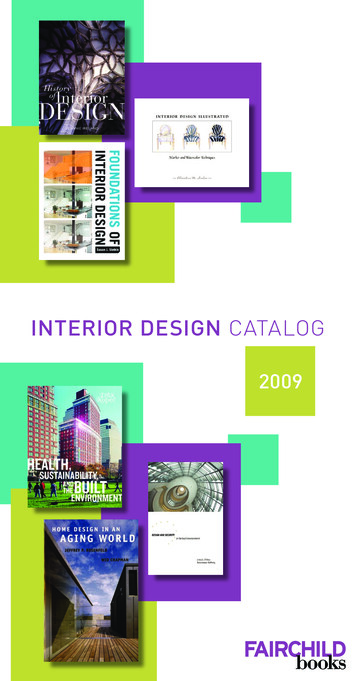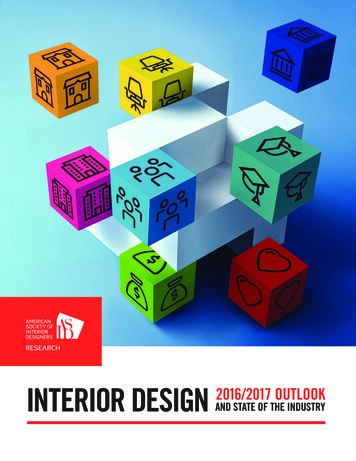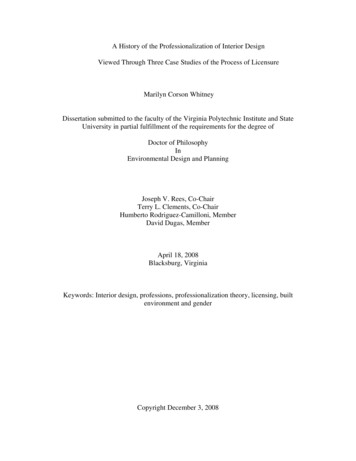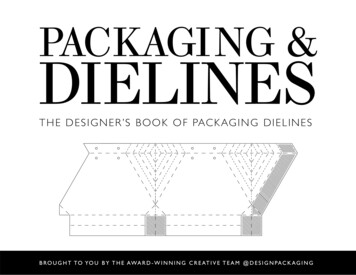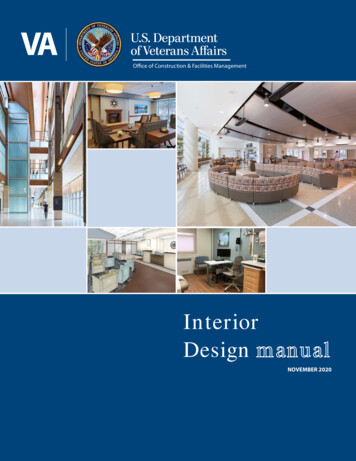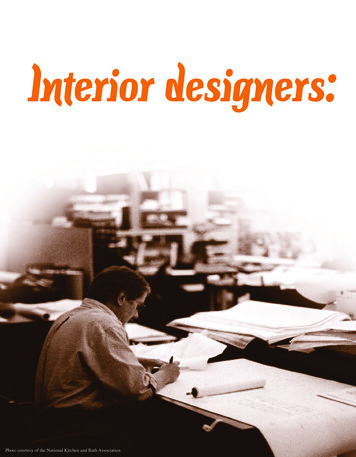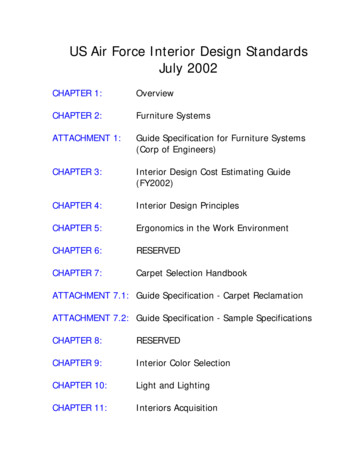
Transcription
INTERIOR DESIGN 101
This report is free to read, share and publish under the terms ofCreative Commons Attribution 3.0 License. 2010 Erica Swanson
INTERIOR DESIGN 101Table of ContentsFunctionUnity & 8393
Great style often flies in the face of established rules. Elusive, easy to recognize and difficult todefine, true style is unconcerned with today’s hottest trend and while it cannot be faked, it cancertainly be nurtured and helped along. Understanding the basic elements and principles ofinterior design will bring you one step closer to understanding how, and when, to break the rulesin creating your own personal style statement.Interior Design is made up of five separate but equally crucial elements: line, form, colour, patternand texture. These five elements, and how closely or loosely they interact with one another,make up a design’s overall composition.Composition, in turn, can be illustrated with seven basic design principles: unity, harmony,rhythm, emphasis, scale, balance and most importantly, function. These principles are the toolsdesigners use to create a successful design scheme; think of function as the overarching objectiveand the remaining principles the means for achieving this success.www.ericaswansondesign.com4
www.ericaswansondesign.com5
I am a firm believer in the axiom, form follows function’. While making a space moreaesthetically appealing is certainly important, no amount of colour or beautiful furniture willtransform an unworkable space into one that functions well. Before you begin any project, it’scrucial to review your lifestyle, patterns, habits, and daily routines before any design ordecorating decisions are made. Is your space supporting or hindering you? Are you able tocomplete your regular routines with ease? Does your home give you a sense of emotionalcomfort and physical ease?While it’s certainly helpful to have an understanding of blueprints and elevations, this stage isreally about common sense; a determination of what needs updating and changing to better suitthe needs of you and your family. Following the questions above, begin by getting clear onyour exact needs now and in the future. For instance, do you need more counter or storagespace in the bathroom for the morning rush? What about extra seating for holiday entertaining?Are your closets bursting with out-of-season clothing or hardly-used linens? Do you have enoughdisplay space for your ever-growing collection of art?www.ericaswansondesign.com6
Once you’ve thought critically about how you live and how your space may or may not beworking for you, you can begin to draw up a Wish List of all the things you’d love if moneywere no object. While all of your ideas may not be possible, lateral thinking often revealssimple solutions to previously unsolvable obstacles.Of course, function refers to the items within your home as well. If you’re inclined to lazy Sundayafternoon naps on the sofa, there’s no sense in purchasing an armless loveseat. If there aresmall children or pets in the house, you might wish to reconsider white upholstered furniture.Every object, from your furniture to your storage racks, should perform efficiently and with theminimum of care and maintenance you can realistically manage.Whether your plans involve a decorative update or a complete to-the-studs overhaul, a homethat functions well is the critical foundation to successful design. Always – function first, formsecond.www.ericaswansondesign.com7
Unity and harmony is simply an orderly blend of lines, forms, colours, patterns and textures.While unity refers to the carful avoidance of visual conflict, harmony assures the assimilation ofvarious elements and objects throughout the room to create a unified whole.Unity describes the relationship between each of the various parts of a space and how theyrelate to one another. If the room is traditional and feminine with a softly coordinating colourpalette, the introduction of heavily linear or starkly modern furniture will throw off the entirecomposition. Similarly, a coat of glossy paint in a singular colour can unify mis-matchedfurniture or frames to create a harmonious connection.Harmony can be achieved by thinking of the overall desired mood of the space. A blend ofsimilar furnishings and monochromatic colours can be used to induce of peaceful, calmingfeeling. Likewise, the introduction of angular objects set against softly rounded pieces can injecta visual tension to produce an exciting, dynamic feeling so long as those pieces have a unifiedfeel and aesthetic. The repetition of frames or other types of artwork can unify a disjointedspace and coordinating fabrics can fuse together upholstered furniture from different eras andstyles to bring the whole seemingly disparate look together.www.ericaswansondesign.com8
While there are no hard and fast rules, unity and harmony are achieved by paying particularattention to the overall look and feel of your space. The goal is to link common furnishings,accessories or decorative elements in colour, style, or form to create an overall pleasing visualeffect.www.ericaswansondesign.com9
Notice how the overall formality of thearchitecture is unified with the furnishingsby the judicious use of colour. The softnessof the walls is echoed in the softly colouredfurnishings and draperies. The area rug’spalette is also soft and subdued.Harmony is achieved with the introductionof dark and moody artwork. While boldlymodern and abstract, the colours are inharmony with the rest of the room and helpunify the scheme by echoing the darkerfinish of the coffee and end tables.Interior design by David Powell of Powell & BonnellPhotography by Ted YarwoodVia Canadian House & Home10
Rhythm is especially powerful. Your eye should move easily around the room from one object toanother without being jarred or “tripped up” by any one object in particular. There areexceptions to this, of course, such as the deliberate placement of a show-stopping piece orsituations in which the furniture placement takes advantage of a captivating view.For most situations, however, the focus should remain on creating a sense of rhythm throughrepetition and contrast to create visual interest. This can be achieved by utilizing the same colouror pattern at various intervals to keep the eye moving throughout the room or by directing the eyeto various points through the use of similar forms or shapes.In any case, rhythm lends a sense of visual cohesiveness and should be considered an importantcomponent of your overall scheme.www.ericaswansondesign.com11
A regular rhythm is achieved bykeeping the intervals between theobjects relatively the same. Thisapproach tends to be formal inappearance.By hanging the images in a grid-likepattern, you eye travels from theartwork to the square furnishings, thento the square coffee table and on tothe square floor tiles. Throughrepetition, your eye is drawn aroundthe room easily without being jarred orstopping abruptly in any one area.Interior design by Joe Serrins StudioPhotography by Vicky MokbelVia Architectural Digestwww.ericaswansondesign.com12
Flowing rhythm has a more natural, organicappearance and isn’t as concerned withuniformity. Flowing rhythm is also generallymuch more relaxed.In this image, your eye is drawn around theroom through the repetition of the circular shape.Beginning with the sculptural mirror to the circulararea rug, on to the circular table and finally tothe circular bolster pillows, the continuity of thecircular shape gives the room a sense of flowand effortless ease.Interior design by Diana VinolyPhotography by Thibault JeansonVia Elle Decorwww.ericaswansondesign.com13
Progressive rhythm, by far the mostdynamic of the three, is concerned withdeliberately leading your eye around theroom for a particular effect. Progressiverhythm is most easily achieved withaccessories such as graduatedaccessories for instance, or with patternsor shapes that force the eye to follow.The circular-backed sofa in the room tothe left draws the eye around the roomin one sweeping motion. Without this,the room may have appeared boxy,stilted and uncomfortably angular.Interior design by Diana VinolyPhotography by Thibault JeansonVia Elle Decorwww.ericaswansondesign.com14
Emphasis refers to the focal point of a space. A natural focal point occurs in rooms with asingular purpose such as a bedroom, where attention is given to the most prominent piece in theroom. Created focal points can be seen in rooms with more than one purpose; living roomsand family rooms, for instance, where the rooms are large enough to contain more than onepoint of visual interest. It must be noted, however, that these two points should never compete;they must blend and relax with each other, making it comfortable for the room to contain both.One of the points of interest should visually dominate and take centre stage’, while the othercreates a balancing effect to the eye. Think of a living or family room that is also the televisionwatching room; either the fireplace or the television should dominate, never both.The emphasis of a room can be created by converging lines, contrasting sizes, the colour andtexture of various pieces in a room, or the arrangement of furniture. Emphasis is crucial inbringing a sense of purpose to a room, lending a more substantial feel and disputing the notionthat the room is for decoration or show only.www.ericaswansondesign.com15
By positioning the furniture andlighting to both face and framethe fireplace, the focal point isemphasized. The softer coloursof the upholstery also helpskeep the eye firmly planted onthe darker stone.Interior design by Andrea CrawfordPhotography by Ted YarwoodVia Canadian House & Homewww.ericaswansondesign.com16
Scale is one of the most difficult principles to master but done effectively, can make the differencebetween a mediocre design and a brilliant one. While proportion is the ratio between the sizeof one object to another, scale refers to how the size of that one object relates to another incontext of the overall space.Think of a gargantuan chandelier for instance; placed in a grand, formal dining room, thechandelier is in proportion to the rest of the room. In a small dining room, however, that samechandelier then becomes the star of the show simply by virtue of its sheer size in relation to theroom and the rest of the furnishings.The general rule of thumb is to vary the sizes and proportions of each object. By ensuring atextural or colour link between them, objects will play against one another for an interesting andexciting effect.www.ericaswansondesign.com17
The oversized shades in this kitchen keep theeye firmly centred on the dining area. Theirgrand scale injects a sense of drama andtheatricality in this otherwise quiet’ space.It should be noted that in a large room, youneed large objects to fill the space and makeit appear more intimate. In smaller rooms,consider introducing a few oversized objectsfor dramatic impact. This will trick the eye intothinking the room is larger than it actually isand lend the room a sense of importance thatsmaller objects simply can’t impart.Interior design by Kelly HoppenPhotography by David GarciaVia Metropolitan Homewww.ericaswansondesign.com18
Balance is the art of creating visual equilibrium or approximating the visual weight of objectsthroughout a room for a balanced look. Balance can be created with symmetry; mirroring oneside of an area or room to the other with furniture, artwork or accessories. While generally moreformal in nature, symmetry is suitable for modern bedrooms or living rooms to lend a clean,calming aesthetic. In order for symmetry to work well, introduce an element of asymmetry tocreate interest and subtly stimulate the overall composition. Whether through a singular piece offurniture, flowers or a small accessory, that one element will create the visual tension required tokeep the design from appearing monotonous or stifling.Balance can also be created with an asymmetrical approach by introducing objects orfurnishings that off-set an imbalanced area in visual weight. This can be achieved throughcolour, size or shape depending on the requirements of the design plan.When planning your design scheme, begin by imagining your room as a grid and ensure thatobjects, artwork, furniture, window treatments or architectural features balance each other incolour, shape, pattern, or scale.www.ericaswansondesign.com19
Not only is this dining roomsymmetrical, it’s alsobalanced by the skilfulplacement of round shapes toplay off the boxy dimensionsof the room.The round mirrors complimentthe rectangular side tablesand the circular pedestaltable brings a softer look tothe ornate mouldings andlinear fireplace.Interior design by Paolo MoschinoPhotography by Timothy KolkVia Elle Decorwww.ericaswansondesign.com20
For an asymmetrical or imbalanced room,balance can be achieved with architecturalelements, furniture or decorative accessories tovisually off-set the unevenness.Although the artwork has been hung offcentre, the scale of the piece on the left isbalanced by the darker colour of the pieceson the right. The two distinctly differentlamps, although similar in colour, also help tiethe overall composition together by framingthe back wall and breaking up the rigidity ofthe square sofa and rectangular frames.Interior design by Paolo MoschinoPhotography by Timothy KolkVia Elle Decorwww.ericaswansondesign.com21
www.ericaswansondesign.com22
Although this element is impossible to isolate from the others, the lines of a room have atremendous impact on the overall look and feel on the space you are trying to create. Your eyewill move around the room according to which lines are present and how those lines interact orintersect with one another. Thus, you can either work with the existing architecture in drawingattention to a particular feature or area or you can distract the eye by drawing attentionelsewhere.There are many ways to manipulate how your eye will move within and throughout the space.Horizontal lines, for instance, give the impression of a relaxed environment. Vertical lines drawthe eye upward and are more active or energetic than horizontal lines. A predominance ofhorizontal and vertical lines without the softer diagonal or curved lines to balance them,however, will have an overly masculine aesthetic. If that’s not your objective, considerintroducing a mix of both strong and soft lines to create a balanced and 3
With its strongly linear lines,this office has a dramaticallymasculine, nearly austereaesthetic.Interior design by Nate BerkusPhotography by Pieter EstersohnVia Elle Decorwww.ericaswansondesign.com24
Diagonal lines are dynamic andwork best in modern, lively interiors;spaces where the added visualenergy makes sense. Note that toomany diagonal lines can inject asense of confusion so these are bestused sparingly.In this image, the eye isimmediately drawn to the overheadbeams. The effect is softenedsomewhat by the arch that bothbisects and bridges the room butthe overall aesthetic is still dramaticand energetic.Interior design by Waldo FernandezPhotography by Firooz ZahediVia Elle Decorwww.ericaswansondesign.com25
Curved or free-flowing lines are soft, unstructuredand feminine in appearance. Think of soft, roundchairs or round frames; both have a much moreyielding appearance than hard lines. Also notethat too many soft lines can impart an aimless, wishy-washy’ appearance so these are bestapplied in smaller doses as well.The feminine aesthetic, created by the soft curvinglines of the sofa, the gently sloping lines of thearmchair, the undulating lines of the ottoman, andthe gently cascading lines of the sconces, iswisely balanced by the strong linear lines of thefireplace and artwork. Otherwise, the room mayhave taken on a weak or imbalancedappearance.Interior design by Waldo FernandezPhotography by Firooz ZahediVia Elle Decorwww.ericaswansondesign.com26
Form is simply the three-dimensional shape created by various lines. Every piece of furniture andaccessory you introduce has a form. Consider what currently exists and how those forms couldbe complimented by the addition or subtraction of competing shapes. A boxy sofa, for instance,might be balanced with a circular coffee table. Bookshelves are often much more pleasing tothe eye with the addition of free-form sculptures and round accessories to balance the linear lookof book spines.As above in our discussion regarding the lines of a space, if you are aiming for a masculinelook, consider square or rectangular shapes to emphasis strong, linear lines. If you are aimingfor a more feminine atmosphere, try adding round or curvy shapes for a softer look.www.ericaswansondesign.com27
Colour is by far the most powerful element of the design process. With the capacity to alteryour mood and shift how you experience a space, colour defines the overall aesthetic directionand should be considered first and foremost before choosing any permanent fixtures. But whilechoosing a scheme can seem like a daunting process, it’s rarely as scary as it seems. Forget thetrends. Forget what the neighbours are doing. Find the colours that speak to you; that yougravitate to again and again. This is where you’ll find the basis for your colour scheme.With that in mind, there are a few hard and fast rules when it comes to colour. Think of thislesson as the foundation. Once you understand how colour works, feel free to bend the rulesand stretch the boundaries. After all, interior design is a very personal thing.www.ericaswansondesign.com28
There have been considerable breakthroughs in the last several years in regards to how weunderstand and relate to colour. For now though, we’ll stick with the tried-and-true colour wheel.Instantly recognizable, the colour wheel illustrates the relationship between primary, secondaryand tertiary colours as outlined below:Primary:Secondary:Tertiary:Red, blue and yellow; the building blocks of the colour palette.Orange, purple and green; the mix of roughly equal parts of the primaries.Everything else; mixes of uneven and variable amounts of primary colours.www.ericaswansondesign.com29
The primary colours are connected by solid lines and the secondary colours by dashed lines.The tertiary colours aren’t connected at all:The relationships of these colours and how they can be utilized for effective and pleasing colourschemes are described .comTriadic30
If you want to create a monochromaticscheme beginning with a soft blue forinstance, start with your favourite blueand layer furniture and textiles in thatsame colour throughout the room for asoft and calming effect.Although this room is a blend ofvarious sky-blues, the overall look isgrounded with the addition of thedarkly stained side chairs and theglass and iron coffee table. All monochromatic schemes require a visualbreak; one or two elements to createenough visual tension to underscorethe monochromatic palette.Interior design by Anne Tarasoff & Gail Tarasoff-SuttonPhotography by Keith Scott MortonVia Elle Decorwww.ericaswansondesign.com31
If you’d like a lively and dynamic colour scheme,consider using complimentary or analogous colours.Even if using softer, less saturated colours, thecontrast will create excitement while still beingharmonious.The colours used in this image are pale and subtlebut by juxtaposing blue against purple, analogouscolours, the room becomes lively and dynamicwithout being jarring.Whichever direction you choose, keep in mind thatcolour, including everything from the colour on thewalls to the colour of your tiniest accessory, willhave an impact on your overall scheme.Interior design by Margot AustinPhotography by Donna GriffithVia www.margotaustin.comwww.ericaswansondesign.com32
Patterns inject a space with personality and are used to both highlight and disguise particularfeatures within a room. Whether on furniture, draperies, area rugs or within artwork, patternscan enliven a space and carry a colour scheme throughout the room. Patterns should beconsidered carefully, however, as without regard to their scale, colouring, or intensity, patternscan overwhelm or dominate an otherwise successful scheme.Three factors must be considered in the selection of patterns: The size of the room versus the amount of the individual pattern in the room. The scale of the shapes and colours of which the pattern is composed. The intensity of colours within the pattern.In general, small patterns consisting of small shapes and subdued colours will have a moresubtle effect than the use of a large pattern with distinct, contrasting colours. Larger patterns,particularly those with brighter or more intense colouring, can visually shrink the room. Similarly,smaller patterns with subtler colours can open up the space and create visual flow throughout theroom if all other elements are in harmonious or complimentary colours.www.ericaswansondesign.com33
As the various patterns in this bedroom aresimilar in scale and colour intensity, none ofthem dominate or overpower the room. Evenwith the busy wallpaper, the deep solidorange bedspread offers some visual reliefand balances the overall scheme.Interior design by Christine d’OrnanoPhotography by Simon UptonVia Elle Decorwww.ericaswansondesign.com34
In contrast to the first image, the lack of patterns inthis crisp black and white living room is no lessdramatic. The black and white colour scheme ispunctuated by the cowhide pattern’, giving asophisticated yet edgy appearance.Interior design by Joseph MimranPhotography by James TseVia Canadian House & Homewww.ericaswansondesign.com35
The final element, texture, refers to the tactile and visual conformity of the surfaces of items withina space, and of the space itself. At its heart, texture can be viewed as a very subtle pattern.Even the grain in wood and the weave of solid fabrics can have just as much impact as anobvious pattern. Think of the textural sensuality of wool and cotton or velvet and silk; in a roomwithout any pattern, these textures help create the depth and complexity necessary for successfuldesign.At the most basic level, there are four primary types of texture:Rough:Smooth:Hard:Soft:Hewn wood and stucco; these textures can visually reduce a space.Glass and chrome; these textures transfer light and visually expand a space.Brick, tile, glossy woods, and opaque glass are considered hard surfaces.Primarily fabrics, but surfaces with a matte finish can also be considered soft.www.ericaswansondesign.com36
The bedroom in this image beckons with itssumptuous textures. From the softness of thelinens, the buttery leather of the side chair, tothe glossy reading table and natural hiderug, the textures in this room offer a sense ofvisual depth and physical comfort.Unlike the other elements of design, textureshave their greatest impact and effect whenused in combination. The contrast of hardand soft, smooth and rough can inject asense of drama and interest.Interior design by Darryl CarterPhotography by Simon UptonVia Elle Decorwww.ericaswansondesign.com37
These five elements and seven principles are the foundation for creating a successful plan andshould be considered at every step in the design process. Of course, while it’s true that rules aremade to be broken, until you have a solid understanding of what those rules are and why theyexist, you’ll never understand how best to bend them to your advantage.Your next task, then, is to apply this knowledge in creating the home you envision. The trick issimple: know who you are. There is no greater design advice a designer can impart to helpyou on your design and decorating journey than to encourage you to make courageousdecisions.With these principles and elements in mind, choose what ignites your passions, makes yourheart skip a beat, gives you pause, or makes you smile. Your truest essence should be reflectedin the place you call home. After all, it’s not about Stuff, it’s about You.www.ericaswansondesign.com38
Whatever you do in your decorating philosophy, be brave.never wish youhadn't taken your vision right to the end. Make a bold statement.Roger Banks-Pye, Colefax and Fowler Interior Inspirationswww.ericaswansondesign.com39
A person with a real flair is a gambler at heart.Billy Baldwinwww.ericaswansondesign.com40
Make every room a living room.Alexandra Stoddardwww.ericaswansondesign.com41
Trust your intuition; it will never, ever fail you.Erica Swansonwww.ericaswansondesign.com42
Interior Design is made up of five separate but equally crucial elements: line, form, colour, pattern and texture. These five elements, and how closely or loosely they interact with one another, make up a design’s overall composition. Composition, in turn, can be illustrated with seven basic design principles: unity, harmony,File Size: 1MBPage Count: 42Explore furtherFree Downloads - Interior Design ebooks on Home Decoratingwww.interiordezine.com15 Free Interior Design Ebooks To Download If You're A .www.essentialhome.eu(PDF) The Fundamentals of Interior Design trung hoang .www.academia.eduPDF Download Architectural Graphic Standards Freewww.nwcbooks.comInterior design final project pdf - SlideSharewww.slideshare.netRecommended to you b

